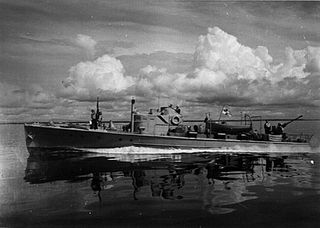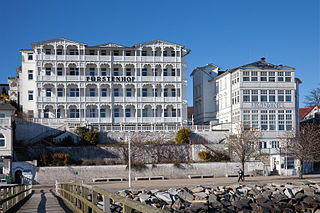
The Finnish Navy is one of the branches of the Finnish Defence Forces. The navy employs 2,300 people and about 4,300 conscripts are trained each year. Finnish Navy vessels are given the ship prefix "FNS", short for "Finnish Navy ship", but this is not used in Finnish language contexts. The Finnish Navy also includes coastal forces and coastal artillery.
Vesikko is a submarine, which was launched on 10 May 1933 at the Crichton-Vulcan dock in Turku. Until 1936 it was named by its manufacturing codename CV 707. Vesikko was ordered by a Dutch engineering company Ingenieurskantoor voor Scheepsbouw in 1930 as a commercial submarine prototype. Purchased by the Finnish before the war, she saw service in the Winter War and World War II, sinking the Soviet merchant ship Vyborg as her only victory. After the cease-fire with the Allies in 1944, Vesikko was retired. Finland was banned from operating submarines after the war and she was kept in storage until she was turned into a museum ship.

The Baltic Sea Campaigns were conducted by Axis and Allied naval forces in the Baltic Sea, its coastal regions, and the Gulf of Finland during World War II. After early fighting between Polish and German forces, the main combatants were Germany and Finland, opposed by the Soviet Union. Sweden's navy and merchant fleet played important roles, and the British Royal Navy planned Operation Catherine for the control of the Baltic Sea and its exit choke point into the North Sea.

The Vetehinen-class submarine was a Finnish 500 tonne submarine class of three vessels that was designed and built in the 1920s and early 1930s. The Vetehinen class served in the Finnish Navy during World War II. The class was designed by Dutch dummy company Ingenieurskantoor voor Scheepsbouw den Haag (I.v.S) and built by the Finnish Crichton-Vulcan shipyard in Turku. The class was based on the German World War I Type UB III and Type UC III submarines and served as prototype for Type VII submarines.

The Soviet evacuation of Tallinn, also called Tallinn disaster or Russian Dunkirk, was a Soviet operation to evacuate the 190 ships of the Baltic Fleet, units of the Red Army, and pro-Soviet civilians from the fleet's encircled main base of Tallinn in Soviet-occupied Estonia during August 1941.

Riilahti was a Ruotsinsalmi class minelayer of the Finnish Navy. Riilahti was commissioned in 1940 and sunk in 1943. The vessel was named after the battle of Riilahti, which was fought between Sweden and Russia in 1714.
The Naval warfare in the Winter War was the naval part of the Winter War between Finland and the Soviet Union from 30 November 1939 to 13 March 1940. Overall, the level of naval activity was low. However, Finland had coastal artillery batteries which took part of battles along its coast.

Submarine warfare in the Black Sea in World War II during 1941 primarily involved engagements between submarines of the Soviet Black Sea Fleet attacking Axis merchantmen defended by Romanian and Bulgarian warships. These engagements were a part of the naval Black Sea campaigns between Axis and Soviet naval forces.

The Gulf of Finland U-boat campaign lasted in the Gulf of Finland during the World War II against the Soviet Union between summer 1944 and spring 1945. During the campaign Finland switched sides and joined the Allies.

The Soviet submarine Baltic Sea campaign in 1943 was launched by the Soviet Navy to harass the strategic iron ore traffic from neutral Sweden to Nazi Germany on the Eastern Front during the WWII. Other operations has been launched by Allies, especially by the Royal Navy. The offensive was a repetition of the previous campaign in 1942 but resulted in a failed outcome.
Submarine warfare in the Black Sea in World War II during 1942 involved engagements between primarily submarines of the Soviet Black Sea Fleet attacking Axis merchantmen defended by Romanian and German naval warships. These engagements were a part of the Black Sea campaigns between Axis and Soviet naval forces.

Submarine warfare in the Black Sea in World War II during 1943 involved engagements between submarines of the Soviet Black Sea Fleet attacking Axis merchantmen defended by Romanian and German naval warships, as well as and German U-boats attacking Soviet merchants on the eastern Black Sea. These engagements were a part of the Black Sea campaigns between Axis and Soviet naval forces.

Submarine warfare in the Black Sea in World War II during 1944 involved engagements between submarines of the Soviet Black Sea Fleet attacking Axis merchantmen, defended by Romanian and German naval warships, as well as German U-boats and Romanian submarines attacking Soviet merchants on the eastern Black Sea. Before the conclusion of the campaign, Romania joined the Allies after King Michael's Coup. These engagements were a part of the naval Black Sea campaigns.

The Soviet submarine Baltic Sea campaign in 1941 was launched by the Soviet Navy at the early stage of Operation Barbarossa. The offensive was hampered by the quick German ground advance and the retreat of Soviet naval vessels from the main Baltic harbors.
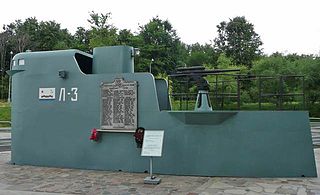
The Soviet submarine Baltic Sea campaign in 1944 was launched by the Soviet Navy to harass enemy shipping and naval military assets of the Nazi Germany on the Eastern Front during World War II.
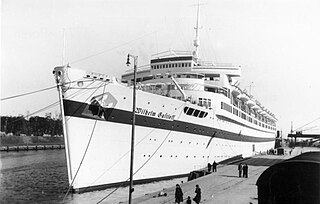
The Soviet naval Baltic Sea campaign in 1945 was launched by the Soviet Navy to harass enemy shipping and naval military assets of Nazi Germany on the Eastern Front during World War II. Both submarines and surface units of the Soviet Navy were employed. The campaign scored successes during Operation Hannibal.
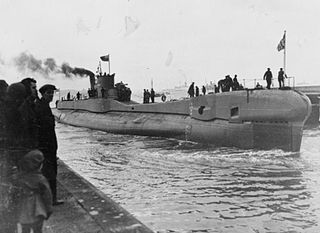
The Barents Sea campaign in 1941 was a submarine operation in the Arctic waters of the Barents Sea during World War II. It was a combined Soviet and British campaign, with boats departing from Polyarny to harass the German shipping lines along the Norwegian coast.




